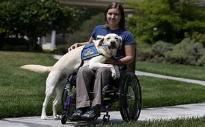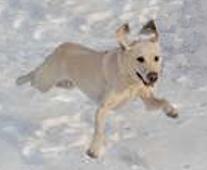| Description The Labrador Retriever is one of the most popular and easily-identifiable dogs in the world. The dog is reasonably large, standing at about two feet at the shoulders and with an extremely heavy and muscular body. Labs have floppy ears, longish noses, long legs relative to their stocky bodies, and distinctive otter-like tails that help them to steer their bodies when swimming. They come in three basic foundation color variations: Chocolate, Black, and Yellow. There is a wide variety of color shades and hues within those three basic foundation colors (all accepted by AKC, UKC, CKC, ACA, etc.), yet classified and registered under one of the three **basic foundation colors: Coat Color Foundation Color Fox Red Yellow **Yellow Yellow Cream Yellow Butterscotch Yellow White Yellow Champagne Yellow Liver Chocolate **Chocolate Chocolate Dark Brown Chocolate Chestnut Chocolate Silver Chocolate **Black Black Smoky Black Black Charcoal Black Coat Description The Labrador Retriever's coat is short and course to the touch. The coat is sometimes slightly waving across the dog's back, but is otherwise straight. Labs have a distinctive insulating undercoat of soft fur. Basic History The Labrador Retriever, contrary to its name, arose from the St. John's Dogs used for fishing in Newfoundland. The St. John's Dog would go out with the fishermen in their boats and retrieve distant lines or nets of fish, hauling them back to the boat. These early purposes for the dog are the most likely reason for the waterproof coat, otter-like tail, high endurance, and love of swimming seen in the Labradors of today. In the late nineteenth century, however, some of the St. John's Dogs were brought to land and trained as gun dogs for aristocratic hunting and retrieving. The more refined dogs became known as "Labrador Dogs" in order to distinguish them from the larger Newfoundland Retriever, developed for some of the same purposes. The popularity of the newly-christened Labrador Retriever as a gun dog and sporting aid led to the breed spreading worldwide, and today the Labrador Retriever is a highly-recognized and distinctive breed in many homes around the world. Overall Temperament The Labrador Retriever is a very active, excitable dog, bred for hunting, temperament, agility and swimming as well as overall energy. This can make it an excellent family pet, and largely accounts for the breeds popularity, but it can also make the breed into a handful and a real challenge for inexperienced dog owners who don't know how to train and handle large, active dogs like the Lab. Although Labs are wonderful dogs once their owners understand how to deal with them, they can be the worst nightmare of people who think that a few pats on the head, a walk now and then, and lots of treats to keep the peace are a viable strategy for owning a dog of this breed. Labs are extremely friendly. This can be a very good thing in that it's easy to introduce your Lab to a new person without lots of barking or aggressive behavior. On the other hand, it can be a very bad thing since the eighty-pound Lab will often express his or her friendliness by jumping on that same new person, sometimes even knocking them down. Although Labs are highly intelligent, they often get a reputation for being fools of the canine world due to their over-exuberance and even hyperactivity. Labs also remain mentally immature for the first 2-3 years of their life. Careful training can get these intelligent dogs to think twice about their actions, however, and can make them "safe for company". A Labrador with manners is a Labrador that will be your best friend for years to come and your friends won't be afraid to come over for fear of being knocked to the ground or covered in slobber. Labs also do fairly well with children, but you should be careful when allowing children to play with a Labrador Retriever. Although the dogs would never knowingly do harm to any member of their "family", they can sometimes knock down and unintentionally harm a smaller child. As a rule, you shouldn't let children play with Labrador Retrievers without supervision until the dog's training is complete and the dog is well out of its puppy years. Anyone who tries to use the Lab as a guard dog will likely be disappointed. Although Labs can be moderate barkers in some situations, the breed is far too friendly and far too non-aggressive to be effective at patrolling a property or running off strangers. A Labs habit of barking can make them good watchdogs in some situations, but often at the cost of good socialization with family members. Most Common Health Problems Although generally healthy, Labrador Retrievers are still prone to the same hip and joint problems that plague most large dogs; Hip Dysplasia and Elbow Dysplasia. They are prone to a few eye disorders as well, Progressive Retinal Atrophy (PRA) being the most serious. They also have large appetites and a tendency toward obesity (especially after being spayed or neutered) which needs to be carefully checked by owners in order to keep their Lab generally healthy. Grooming The Labrador Retriever's waterproof coat is designed to self-clean in several important ways, which minimizes your responsibility for grooming to some extent. But without a regular schedule of grooming in some important areas, the overall health of your dog can decline, so the Lab's miraculous coat can't simply be left to do its work in isolation. The Lab's course outer coat and undercoat should be brushed about once a week in order to remove any dead hair and to alleviate shedding. Labs can be bathed on occasion without problems, although shampoo should be used lightly in order to avoid damaging the waterproofing on the Lab's outer coat. Often a simple dip in a nearby pool or river can do the trick for cleaning off a Lab. The Lab's ears should be checked on a regular basis for signs of parasites or infections. Drop-eared dogs (ears that don't stand erect) are at a high risk for this kind of ear problems, and regular cleaning and inspection of the Lab's ears can help with prevention. The Lab's course coat and active lifestyle can also cause small bits of dirt, leaves, or even parasites to get caught close to the dog's skin, causing irritation. Regular brushing and occasional baths will take care of most of this, but a quick inspection of the Lab's body from time to time can help you to know when the best time for a brushing or bath is, and can help to find and remove parasites before they become health problems for the dog. Exercise Labrador Retrievers are very excitable and will require a great deal of exercise, especially during the first three years of their lives. At a bare minimum, you should expect to take your dog for about two walks a day. Make sure to use a strong leash, as Labs have very powerful neck and shoulder muscles and can easily pull you off balance if you aren't careful. Beyond these walks, however, you'll need to give your Labrador some room to get out all of the exercise he or she needs. A yard is the best for this kind of activity, and a fenced yard is vital to keep your dog from wandering off or chasing strangers or other animals. Remember, the Lab was bred for hunting and retrieval. Since Labs are powerful jumpers, you need to make sure that you have an adequate fence in place in order to keep your Lab from escaping. Four feet of fencing will stop all but the most dedicated of jumpers, while six feet will be an impassible barrier to any Lab. Your dog isn't likely to try escaping unless he or she is otherwise bored or unhappy, which shouldn't be the case. Toys and bones can help alleviate boredom. Labs are also natural and enthusiastic swimmers. If you have access to any kind of water (rivers, beaches, lakes, swimming pools, ponds) you should make a point of using these as ideal exercise venues for your Lab. Although all Labs naturally excel at swimming, younger Labs may need some time to get used to the water, and all Labs should be introduced to the water only near natural "steps" or other shallow regions. This ensures that the dog will know how to get out of the water whenever he or she starts to tire, or whenever he or she simply gets bored with swimming for the day. Under no circumstances allow your Lab to simply jump into deep water and hope for the best. Even the best swimmers can't keep afloat if they don't know how to get out of the water when they need to. If you're worried about the exuberance or activity of your dog, remember this and be comforted: Labrador Retrievers are quick to mature physically, but slow to mature mentally. Until sometime in their third year, your Lab will likely have the mind of a puppy but the body of an adult dog. This is not a problem that will last throughout the dog's life, and your Lab will naturally become much calmer with advancing age. Training The Labrador Retriever is an extremely excitable dog, known for its love for swimming, pulling on leashes, and jumping on friends and family members to show its excitement. This kind of behavior is normal for many dogs, but for the Labrador Retriever, which usually weighs at least sixty pounds, (and often much more), it can be a serious problem. No one wants to be jumped on by an eighty-pound dog if they can help it, but over-excited and under-trained Labs can knock down and injure children or smaller adults, and it's simply a hassle to deal with as a dog owner. So training for your Lab should start as early as possible. At about ten to twelve months, Labs are fully-grown, physically, at least. Mentally, Labs require about three years to fully develop and training at this point becomes much more difficult simply due to the dog's large size. So introducing simple commands ("sit", "off", "down", "stay", and "heel" in particular) should be done before that six-month threshold in order to make later training much more manageable, and to discourage jumping and other rude behavior. Ten weeks of age seems to be a good starting point to begin training. Consistency and positive rewards for good behavior (as opposed to negative punishments for bad behavior) are mainstays of any effective dog training, and both will work well with a Lab. Although an individual trainer can be perfectly consistent with a Lab, where rewarding good behavior and discouraging bad behavior are concerned, the Lab will form its behavior patterns based on its entire human "family"--meaning that if one human tolerates jumping while another human forbids it, the Lab will usually continue to jump due to the "mixed messages". It's important to make everyone in your family aware of what rules the Lab is to follow and to make sure that everyone enforces those rules. Although Labs are very intelligent and can learn rules of behavior quickly, they can be just as quick to "unlearn" rules that don't make sense to them. So be as consistent with the rules as possible. Positive rewards for good behavior should also be verbal rewards or rewards of affection...soothing voices, petting, and other similar rewards, as opposed to food rewards, although treats in moderation in the beginning work very well as an initiative. Labs have a tendency toward overeating, and offering food rewards for good behavior can contribute heavily to this problem if not watched closely. |
Avg. Life Span: 10-12 years Avg. Litter Size: 8 puppies Group: Sporting Dog, Gun Dog Recognized By: AKC, ACA, CKC, FCI, UKC, ANKC, NKC, APRI, ACR, NZKC, & others Some registries/clubs still do not recognize the Dilutes as pure Labrador Retrievers, but most now do thanks in part to the prior investigations done by AKC to prove parentage. With AKC, Dilute colors are registered under their foundation colors; Charcoal ->Black; Silver->Chocolate; Champagne->Yellow. Standard Colors: Black, Yellow, Chocolate Dilute Colors: Charcoal (dark gray), Champagne (a shade from White to Yellow), Silver (light gray) Hair Length: Short Size: Large Shedding: Moderate Shed Male Height: 22-24 in (56-61 cm) Male Weight: 65-80 lbs (27-36 kg) Female Height: 21-23 in (53-58 cm) Female Weight: 55-70 lbs (25-32 kg) |
| General Statistics |
| Breed Specific Information About Labrador Retrievers Of All Colors |
| The English Lab v/s The Field Lab |
| The English types have show dogs in their pedigree. If a dog has earned championship status in the show ring for conformation (being the closest specimen to the breed standard or ideal), he gets a "Ch." before his name. Lots of "Ch.'s" in the pedigree indicate that a dog had a lot of ancestors that were also judged to be closest to the ideal of the breed. They are active pups who tend to settle down with good, positive training and can make great family companions. They are the dogs bred for the show ring, with conformation (physical appearance) and temperament as first priorities. The Field types have lots of field titles in their pedigree and are usually much more active. Field types have been specifically bred to have the qualities necessary for a successful hunting dog: boundless energy and more endurance than most families want in a pet dog. Field trial champions are like Olympic athletes...too high an activity level in a family pet isn't desirable unless you plan to put the dog to work doing extremely active tasks, such as training for field trials (as the name suggests). These dogs take a lot of training and are a great choice for the person who wants to actively participate with his or her dog in field trials and who has the money and time to spare. |
| Before you decide to become an owner of a Labrador Retriever, PLEASE read the following information and make sure a Labrador Retriever is the right breed for you and your family. |






















